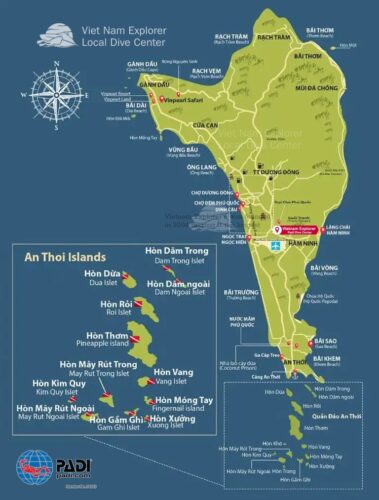Diving in Phu Quoc: Discovering the Raw Pearl of the Gulf of Thailand
If Nha Trang is the well-known, friendly debutante, then Phu Quoc is the raw pearl—wild, pristine, and full of unexpected discoveries. Located in the warm waters of the Gulf of Thailand, Phu Quoc’s underwater ecosystem has a completely different character than the central coast, offering a fresh experience even for divers familiar with Vietnam.
As part of our Complete Guide to Diving in Vietnam, this in-depth Amadive article will take you beyond the famous white-sand beaches to discover a world of diverse hard corals, unique marine creatures, and deserted southern islands.

What Makes Diving in Phu Quoc Different?
- A Hard-Coral Dominated Ecosystem: Unlike the soft coral diversity in Nha Trang, Phu Quoc is the kingdom of hard corals, especially massive and table corals, which create majestic landscapes and complex structures.
- Opportunities to See Unique Marine Life: The Gulf of Thailand is home to species you’d be hard-pressed to find in other Vietnamese waters, such as bamboo sharks, scorpionfish, and large cuttlefish.
- Year-Round Diving (If You Know Where to Go): Thanks to its unique geography, Phu Quoc has two main dive areas (North and South) that are affected by monsoons at different times, allowing diving activities to take place almost all year.
- A “Robinson Crusoe” Experience: Many dive sites are located around small, deserted islands in the south, providing a sense of exploration and an escape from the crowds.
An In-Depth Look at the Top Dive Sites
Diving in Phu Quoc is primarily split between two areas: the An Thoi archipelago in the south and Ganh Dau in the north.
1. Turtle Island (North)
- Who is it for? All levels, especially those who enjoy interesting rock topography.
- The Experience: A dive here is like exploring an underwater rock maze. You will swim through and around large boulders covered in coral, creating numerous small crevices and hideouts for marine life. The depth ranges from 5 to 12 meters.
- Marine Life Spotlight: Large groupers, butterflyfish, and sometimes bamboo sharks resting under the rock ledges.
2. An Thoi Archipelago – “Airport Reef” (South)
- Who is it for? All levels, great for a relaxing drift dive.
- The Experience: It gets its nickname because the reef is long and flat like a runway, starting at about 6 meters and gently sloping down to 18 meters. The entire area is covered by a healthy carpet of hard corals. It’s an easy dive, allowing you to drift gently and take in the panoramic view.
- Marine Life Spotlight: Cuttlefish are often seen hovering over the reef, various species of sea cucumbers are present, and large schools of damselfish are abundant.
3. Nudibranch Garden (South)
- Who is it for? Experienced divers and macro photographers.
- The Experience: This is not a dive for sightseeing. This is a treasure hunt. You will dive very slowly along a sloping reef at around 12-20 meters, focusing on finding tiny creatures. A good dive light and a keen eye are mandatory.
- Marine Life Spotlight: True to its name, this is a paradise for nudibranchs, with dozens of different species. You can also find ghost pipefish and mantis shrimp.
Planning Your Trip
- The Best Diving Season: The ideal time to dive in Phu Quoc is the dry season, from late October to April. The sea in both the north and south is calm, and visibility can reach 15-20 meters.
- Water Conditions: The water is very warm, from 28°C to 31°C. A shorty or a 1.5mm thin wetsuit is sufficient.
- Advice from Amadive’s Experience: The rainy season (May – October) is affected by the southwest monsoon, which makes the southern sea (where the best dive sites are) rough. However, the northern sites can still be diveable. Always check with your dive center about the conditions before booking.
Frequently Asked Questions (FAQ)
- Is diving in Phu Quoc difficult?
- No. Most dive sites in Phu Quoc are relatively shallow with mild currents, making them very suitable for beginners and all experience levels.
- Am I guaranteed to see a bamboo shark?
- Nothing is 100% guaranteed in nature, but the chances are quite high, especially if you dive at sites with many rock overhangs. Ask your dive guide to show you where they often rest.
Conclusion: A Different Taste of Vietnam’s Seas
Phu Quoc offers a unique diving experience, a perfect complement for those who have already explored the central coast. With its majestic hard coral reefs, the characteristic marine life of the Gulf of Thailand, and a pristine feeling, the pearl island will surely leave a lasting impression in your logbook.
